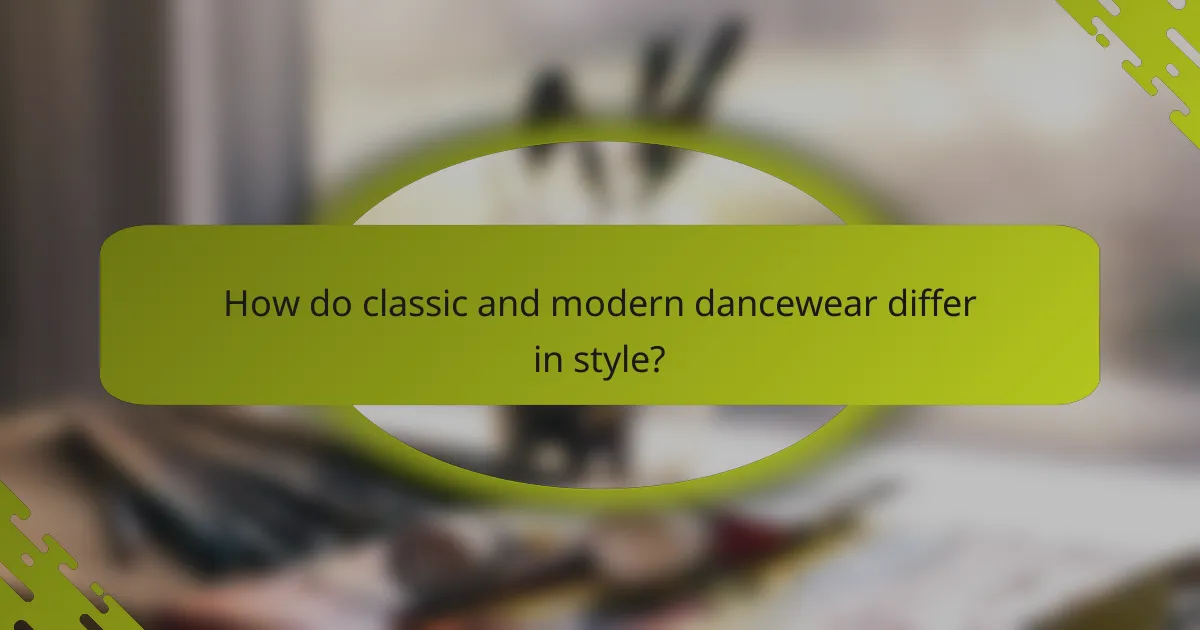Choosing the right dancewear is crucial for both classic and modern performances, as each style serves distinct purposes and enhances a dancer’s expression. Classic dancewear focuses on elegance and functionality, featuring items like ballet tights and tutus, while modern dancewear prioritizes comfort and flexibility with pieces such as hip-hop sneakers and loose-fitting tops. Understanding these differences can help dancers select the most suitable attire for their performances.

What are the best dancewear options for classic performances?
The best dancewear options for classic performances emphasize elegance, comfort, and functionality. Key pieces include ballet tights, leotards, tutus, and considerations between footed and footless tights, each serving specific roles in enhancing a dancer’s performance.
Ballet tights
Ballet tights are essential for classic performances, providing a smooth, streamlined look that enhances the dancer’s lines. They typically come in various colors, with pink being the most traditional for ballet. When selecting tights, consider the thickness and material; options range from lightweight to warmer styles for colder venues.
Ensure a proper fit to avoid discomfort during performances. Look for tights with a good amount of stretch and durability, as they should withstand rigorous movement. Brands often offer sizes based on height and weight, so check sizing charts carefully.
Ballet leotards
Ballet leotards are foundational pieces of dancewear, offering support and freedom of movement. They come in various styles, including tank, short sleeve, and long sleeve, allowing dancers to choose based on personal preference and comfort. Classic colors like black, white, and pink are popular, but vibrant hues can also be suitable for performances.
When selecting a leotard, consider the fabric’s breathability and stretch. Look for features like adjustable straps or built-in bras for added comfort. Ensure the leotard fits snugly without being restrictive, allowing for full range of motion during dance routines.
Classical tutus
Classical tutus are iconic in ballet, characterized by their layered, stiff tulle that creates a distinctive silhouette. They come in various styles, including full tutus and romantic tutus, each suited for different types of performances. Full tutus are often used in traditional ballets, while romantic tutus are longer and flowier, suitable for contemporary interpretations.
When choosing a tutu, consider the length and style that best fits the choreography. A well-fitted tutu should allow for ease of movement while maintaining its shape. Custom-made options are available for those seeking a perfect fit, but off-the-rack styles can also be suitable for many dancers.
Footed vs. footless tights
Footed tights cover the entire foot, providing warmth and a polished look, while footless tights allow for greater flexibility and are often preferred for contemporary dance styles. Footed tights are ideal for traditional ballet performances, ensuring a seamless appearance from leg to foot.
When deciding between footed and footless tights, consider the type of performance and personal comfort. Footless tights can be paired with dance shoes for better grip and movement, while footed tights are typically worn with ballet slippers. Assess the venue’s temperature and your personal preference for warmth and mobility when making your choice.

What are the best dancewear options for modern performances?
The best dancewear options for modern performances include hip-hop sneakers, modern dance leggings, loose-fitting tops, and dance shorts. These styles provide comfort, flexibility, and a contemporary aesthetic that enhances movement and expression on stage.
Hip-hop sneakers
Hip-hop sneakers are designed for agility and support, making them ideal for modern dance styles. Look for shoes with a flexible sole and good grip to facilitate quick movements and turns. Brands often offer styles that blend fashion with functionality, allowing dancers to express their personal style while maintaining performance standards.
When choosing hip-hop sneakers, consider factors such as cushioning and ankle support, especially if you perform frequently. Popular choices often range from $50 to $150, depending on the brand and features.
Modern dance leggings
Modern dance leggings are essential for comfort and freedom of movement. They typically feature stretchy materials that allow for a full range of motion, making them suitable for various dance techniques. Opt for high-waisted styles for added support and coverage during dynamic movements.
Leggings come in various lengths, including full-length and capri styles, and can be found in diverse colors and patterns. Prices generally range from $30 to $100, depending on the brand and fabric quality.
Loose-fitting tops
Loose-fitting tops are popular in modern dance for their breathability and ease of movement. These tops can vary from tank tops to oversized tees, allowing dancers to express their style while staying comfortable. Look for lightweight fabrics that wick away moisture to keep you cool during performances.
When selecting a loose-fitting top, consider the cut and length. Longer tops can provide extra coverage, while cropped styles may enhance mobility. Prices typically range from $20 to $70.
Dance shorts
Dance shorts offer a versatile option for modern performances, combining style with functionality. They allow for freedom of movement and can be layered over leggings or worn alone. Choose shorts with an elastic waistband for a secure fit that stays in place during routines.
Available in various lengths and styles, dance shorts can be found in both fitted and loose designs. Expect to pay between $25 and $80, depending on the material and brand. Consider your performance environment when selecting the length and style of shorts to ensure comfort and appropriateness.

How do classic and modern dancewear differ in style?
Classic dancewear typically emphasizes traditional forms and techniques, while modern dancewear focuses on contemporary expressions and comfort. The differences in style reflect the evolution of dance itself, catering to the specific needs of various performance types.
Fit and silhouette
Classic dancewear often features a fitted silhouette that accentuates the dancer’s body lines, such as leotards and tutus. This style is designed to enhance movement precision and showcase technique. In contrast, modern dancewear tends to prioritize comfort and freedom of movement, often incorporating looser fits and layered styles, such as oversized tops and wide-leg pants.
Material and flexibility
Classic dancewear is usually made from materials like cotton, spandex, and nylon, which provide support and structure. These fabrics help maintain form during performances. Modern dancewear, however, often utilizes a wider variety of materials, including breathable fabrics and blends that enhance flexibility and allow for greater range of motion, such as jersey and mesh.
Color palettes
Classic dancewear typically adheres to a more subdued color palette, often featuring pastels or neutral tones that align with traditional aesthetics. This approach helps to maintain focus on the dancer’s movements. Modern dancewear embraces bolder colors and patterns, reflecting current fashion trends and personal expression, allowing dancers to showcase their individuality on stage.

What factors should I consider when choosing dancewear?
When choosing dancewear, consider comfort, fit, performance needs, and brand reputation. These factors will help ensure that your attire enhances your movement and supports your overall performance.
Comfort and fit
Comfort and fit are crucial when selecting dancewear, as they directly affect your ability to move freely. Look for materials that are breathable and stretchy, allowing for a full range of motion. Ensure that the fit is snug but not restrictive, as overly tight clothing can hinder performance.
Try on different styles and sizes to find what feels best for your body type. Remember that various dance styles may require different fits; for instance, ballet leotards often have a tighter fit compared to the looser styles used in contemporary dance.
Performance needs
Your performance needs will dictate the type of dancewear you should choose. For example, if you are performing in a style that involves a lot of floor work, consider durable fabrics that can withstand wear and tear. Conversely, styles that require high flexibility may benefit from lighter, stretchier materials.
Additionally, consider the climate and venue where you will perform. If you are dancing in a warm environment, opt for lighter fabrics that wick moisture away, while cooler settings may require layering options for warmth.
Brand reputation
Brand reputation can play a significant role in your choice of dancewear. Established brands often have a history of producing high-quality, durable products that are well-suited for various dance styles. Research customer reviews and seek recommendations from fellow dancers to identify brands that consistently deliver on comfort and performance.
While popular brands may come with a higher price tag, investing in reputable dancewear can lead to better longevity and performance, ultimately enhancing your dance experience. Consider trying on items from different brands to assess their fit and feel before making a purchase decision.

How do I care for my dancewear?
Caring for your dancewear is essential to maintain its quality and longevity. Proper washing, storage, and repair techniques will help keep your garments in top condition for performances and practice.
Washing instructions
When washing dancewear, always check the care label for specific instructions. Generally, it’s best to hand wash in cold water with a gentle detergent to avoid damage. If machine washing, use a delicate cycle and place items in a mesh laundry bag to prevent snagging.
Avoid using fabric softeners, as they can affect the elasticity of the materials. Air drying is preferable; lay the garments flat or hang them to prevent stretching and maintain their shape.
Storage tips
Store your dancewear in a cool, dry place away from direct sunlight to prevent fading and deterioration. Use padded hangers for items like leotards and costumes to maintain their form, while folding less structured pieces neatly to avoid creasing.
Consider using breathable garment bags for added protection, especially for costumes that are used infrequently. Ensure that your storage area is free from moisture to avoid mold and mildew.
Repairing minor damages
For small tears or loose seams, a simple needle and thread can often suffice for repairs. Use a thread that matches the color of your dancewear to keep repairs discreet. If the fabric is stretchy, opt for a zigzag stitch to maintain elasticity.
For minor stains, spot clean with a gentle stain remover before washing. If the damage is beyond simple repairs, consult a professional tailor who specializes in dancewear to ensure the best results.

What are the top brands for classic dancewear?
When it comes to classic dancewear, several brands stand out for their quality and reputation. These brands are known for their craftsmanship, comfort, and style, making them favorites among dancers of all levels.
Bloch
Bloch is a leading name in classic dancewear, renowned for its extensive range of products including ballet shoes, leotards, and tights. Founded in Australia, Bloch combines traditional craftsmanship with modern technology to create durable and comfortable dancewear.
When selecting Bloch products, consider your specific dance style and fit preferences. For instance, their ballet shoes come in various widths and materials, allowing for a tailored fit that enhances performance. Many dancers appreciate the quality of Bloch’s canvas and leather options, which provide different levels of support and flexibility.
To ensure you choose the right size, refer to Bloch’s sizing chart and consider trying on different styles to find what feels best. It’s common for dancers to have a few pairs for different performances, so investing in Bloch’s versatile offerings can be a smart choice.









